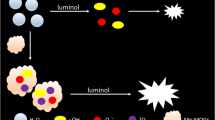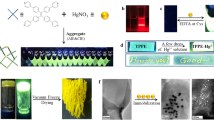Abstract
Metal–organic gels (MOGs) emerged as an attractive luminescent soft material for electrochemiluminescence (ECL). In this work, a cathodic ECL-activated europium metal–organic gel (Eu-MOG) has been synthesized by a facile mixing of Eu3+ with 4′-(4-carboxyphenyl)-2,2′:6′,2′′-terpyridine (Hcptpy) under mild conditions. The prepared Eu-MOG is highly mesoporous for co-reactant permeation to produce an ultra-stable and high-efficient ECL, based on the antenna effect of Eu3+ coordinating with Hcptpy. Moreover, dipicolinic acid (DPA) can competitively coordinate with Eu3+ instead of water molecules, producing an enhanced ECL signal. Therefore, an ECL enhancement assay was developed for DPA detection. There was a linear relationship between the ECL intensity and the logarithmic concentration of DPA in the 0.01–1 μM range, and the detection limit is 7.35 nM. This work displays the promising application of Eu-MOG in the ECL field, opening a broad inspection for seeking a new generation of ECL luminophores.
Graphical Abstract







Similar content being viewed by others
Data Availability
The authors declare that the data supporting this study are available within the paper. The raw data files are available from the corresponding author upon reasonable request.
References
Han ZG, Yang ZF, Sun HS, Xu YL, Ma XF (2019) Electrochemiluminescence platforms based on small water-insoluble organic molecules for ultrasensitive aqueous-phase detection. Angew Chem 58:5915–5919
Tokel NE, Bard AJ (1972) Electrogenerated chemiluminescence IX electrochemistry and emission from systems containing tris(2,2’-bipyridine) ruthenium(II) dichloride. J Am Chem Soc 94:2862–2863
Mayer M, Takegami S, Neumeier M, Rink S (2018) Electrochemiluminescence bioassays with a water-soluble luminol derivative can outperform fluorescence assays. Angew Chem 57:408–411
Peng HP, Huang ZN, Sheng YL, Zhang XP, Deng HH (2019) Pre-oxidation of gold nanoclusters results in a 66% anodic electrochemiluminescence yield and drives mechanistic insights. Angew Chem 58:11691–11694
Jin ZC, Zhu XR, Wang NN, Li YF, Lei JP (2020) Electroactive metal-organic frameworks as emitters for self-enhanced electrochemiluminescence in aqueous medium. Angew Chem 59:10446–10450
Jie G, Liu B, Pan H, Zhu JJ, Chen HY (2007) CdS nanocrystal-based electrochemiluminescence biosensor for the detection of low-density lipoprotein by increasing sensitivity with gold nanoparticle amplification. Anal Chem 79:5574–5581
Terech P, Gebel G, Ramasseul R (1996) Molecular rods in a zinc(II) porphyrin/cyclohexane physical gel: neutron and x-ray scattering characterizations. Langmuir 12:4321–4323
Sengupta S, Mondal R (2016) A novel low molecular weight supergelator showing an excellent gas adsorption dye adsorption self-sustaining and chemosensing properties in the gel state. RSC Adv 6:14009–14015
Barman S, Garg JA, Blacque O, Venkatesan K, Berke H (2012) Triptycene based luminescent metal-organic gels for chemosensing. Chem Commun 48:11127–11129
Liu YR, He LS, Zhang JY, Wang XB, Su CY (2009) Evolution of spherical assemblies to fibrous networked Pd(II) metallogels from a pyridine-based tripodal ligand and their catalytic property. Chem Mater 21:557–563
Sebastian A, Mahato MK, Prasad E (2019) A mixed ligand approach towards lanthanide-based gels using citric acid as assembler ligand white light emission and environmental sensing. Soft Matter 15:3407–3417
Tam AYY, Yam VWW (2013) Recent advances in metallogels. Chem Soc Rev 42:1540–1567
Sun YY, Dramou P, Song ZR, Zheng LM, Zhang XN (2022) Lanthanide metal doped organic gel as ratiometric fluorescence probe for selective monitoring of ciprofloxacin. Microchem J 179:107476
Weng GS, Thanneeru S, He J (2018) Fluorochromic hydrogels dynamic coordination of Eu-iminodiacetate to control fluorochromic response of polymer hydrogels to multistimuli. Adv Mater 30:1706526
Zhang YJ, Wang TL, Guo HQ, Gao X, Yan Y (2023) An ion-coordination hydrogel based sensor array for point-of-care identification and removal of multiple tetracyclines. Biosens Bioelectron 231:115266
Li Y, Jiang ZW, Xiao SY, Huang CZ, Li YF (2018) Terbium(III) organic gels novel antenna effect-induced enhanced electrochemiluminescence emitters. Anal Chem 90:12191–12197
Wang C, Han Q, Liu PK, Zhang G, Fu YZ (2021) A superstable luminescent lanthanide metal organic gel utilized in an electrochemiluminescence sensor for epinephrine detection with a narrow potential sweep range. ACS Sens 6:252–258
Zhang X, Nie YX, Zhang Q, Liang ZH, Ma Q (2021) Polydopamine nanoparticles@MoS2 nanosheet aerogel-based ECL sensing system for MiRNA-126 detection. Chem Eng J 411:128428
Heffern MC, Matosziuk LM, Meade TJ (2014) Lanthanide probes for bioresponsive imaging. Chem Rev 114:4496–4539
Kielar F, Montgomery CP, New EJ, Parker D, Poole RA (2007) A mechanistic study of the dynamic quenching of the excited state of europium(III) and terbium(III) macrocyclic complexes by charge or electron transfer. Biomol Chem 5:2975
Wu M, Jiang ZW, Zhang P, Gong X, Wang Y (2023) Energy transfer-based ratiometric fluorescence sensing anthrax biomarkers in bimetallic lanthanide metal-organic frameworks. Sens Actuators B 383:133596
Leng XL, Shi DL, Yang XP, Zhang Z, Li H (2022) Construction of a luminescent square-like Cd6Eu2 nanocluster for the quantitative detection of 2,6-dipicolinic acid as an anthrax biomarker. J Mater Chem C 10:3510–3516
Cheng ZH, Liu X, Zhang SQ, Yang T, Wang JH (2019) A placeholder strategy with upconversion nanoparticles-eriochrome black T conjugate for rapid colorimetric assay of anthrax biomarker. Anal Chem 91:12094–12099
Rong MC, Deng XZ, Chi ST, Huang LZ, Zhou YB (2018) Ratiometric fluorometric determination of the anthrax biomarker 2,6-dipicolinic acid by using Europium(III)-doped carbon dots in a test stripe. Microchim Acta 185:201
Zhang XY, Young MA, Lyandres O, Duyne RPV (2005) rapid detection of an anthrax biomarker by surface-enhanced Raman spectroscopy. J Am Chem Soc 127:4484–4489
Tan C, Wang Q, Zhang CC (2011) Optical and electrochemical responses of an anthrax biomarker based on single-walled carbon nanotubes covalently loaded with terbium. Chem Commun 47:12521–12523
Wang X, Wang Y, Wang XY, Hu CY, Wu XJ (2022) Dual-ligand two-dimensional europium-organic gels nanosheets for ratiometric fluorescence detecting anthrax spore biomarker. Chem Eng J 435:134912
Yuan M, Jin Y, Yu L, Bu YM, Sun MT (2023) Europium-modified carbon nitride nanosheets for smartphone-based fluorescence sensitive recognition of anthrax biomarker dipicolinic acid. Food Chem 398:133884
Kirby AF, Foster D, Richardson FS (1983) Comparison of 7FJ ← 5D0 emission spectra for Eu(III) crystallne environments of octahedral, near-octahedral and trigonal symmetry. Chem Phys Lett 95:6
Zhang XX, Zhang WJ, Li G, Xin ZW, Liu YX (2019) Preparation of a novel graphene oxide/rare-earth complexes hybrid material and its luminescent film. Opt Mater 98:109425
Li H, Li YJ, Zhang Z, Pang XL, Yu XD (2019) Highly selective luminescent sensing of Cu2+ in aqueous solution based on a Eu(III)-centered periodic mesoporous organosilicas hybrid. Mater Des 172:107712
Han L, Dong XZ, Liu SG, Wang XH, Ling Y (2023) A multi-ratiometric fluorescence sensor integrated intrinsic signal amplification strategy for a sensitive and visual assay of the anthrax biomarker based on a bimetallic lanthanide metal-organic framework. Environ Sci Nano 10:683–693
Shi W, Zhang SQ, Wang Y, Xue YD, Chen ML (2022) Preparation of dual-ligands Eu-MOF nanorods with dual fluorescence emissions for highly sensitive and selective ratiometric/visual fluorescence sensing phosphate. Sens Actuators B 367:132008
Wu QR, Wang JJ, Hu HM, Fu F, Xue GL (2011) A series of lanthanide coordination polymers with 4′-(4-carboxyphenyl)-2,2′:6′,2″-terpyridine: syntheses, crystal structures and luminescence properties. Inorg Chem Commun 14:484–488
Liu ZX, Sun YH, Feng Y, Chen H, Fan QH (2016) Halogen-bonding for visual chloride ion sensing: a case study using supramolecular poly(aryl ether) dendritic organogel systems. Chem Commun 52:2269–2272
Huo PP, Li ZJ, Yao RH, Fan CB, Pu SZ (2022) Dual-ligand lanthanide metal-organic framework for ratiometric fluorescence detection of the anthrax biomarker dipicolinic acid. Spectrochim Acta A 282:121700
Yilmaz MD, Oktem HA (2018) Eriochrome black T-Eu3+ complex as a ratiometric colorimetric and fluorescent probe for the detection of dipicolinic acid, a biomarker of bacterial spores. Anal Chem 90:4221–4225
Qu SM, Song NZ, Xu GX, Jia Q (2021) A ratiometric fluorescent probe for sensitive detection of anthrax biomarker based on terbium-covalent organic polymer systems. Sens Actuators B 290:9–14
Ikeno S, Meakawa T, Hara N (2022) Multi-functional silver nanoparticles for high-throughput endospore sensing. Biosensors 12:68
Acknowledgements
This project was financially supported by the National Natural Science Foundation of China (22004054), Natural Science Foundation of Fujian Province (2020J05163, 2021J01991), and Principal Fund of Minnan Normal University (KJ18014, L21946, KJ2023002).
Author information
Authors and Affiliations
Corresponding authors
Ethics declarations
Conflict of interest
The authors declare no competing interests.
Additional information
Publisher's Note
Springer Nature remains neutral with regard to jurisdictional claims in published maps and institutional affiliations.
Rights and permissions
Springer Nature or its licensor (e.g. a society or other partner) holds exclusive rights to this article under a publishing agreement with the author(s) or other rightsholder(s); author self-archiving of the accepted manuscript version of this article is solely governed by the terms of such publishing agreement and applicable law.
About this article
Cite this article
Xiong, Y., Yang, W., Huang, S. et al. Competitive substitution in europium metal–organic gel for signal-on electrochemiluminescence detection of dipicolinic acid. Microchim Acta 190, 426 (2023). https://doi.org/10.1007/s00604-023-06007-3
Received:
Accepted:
Published:
DOI: https://doi.org/10.1007/s00604-023-06007-3




